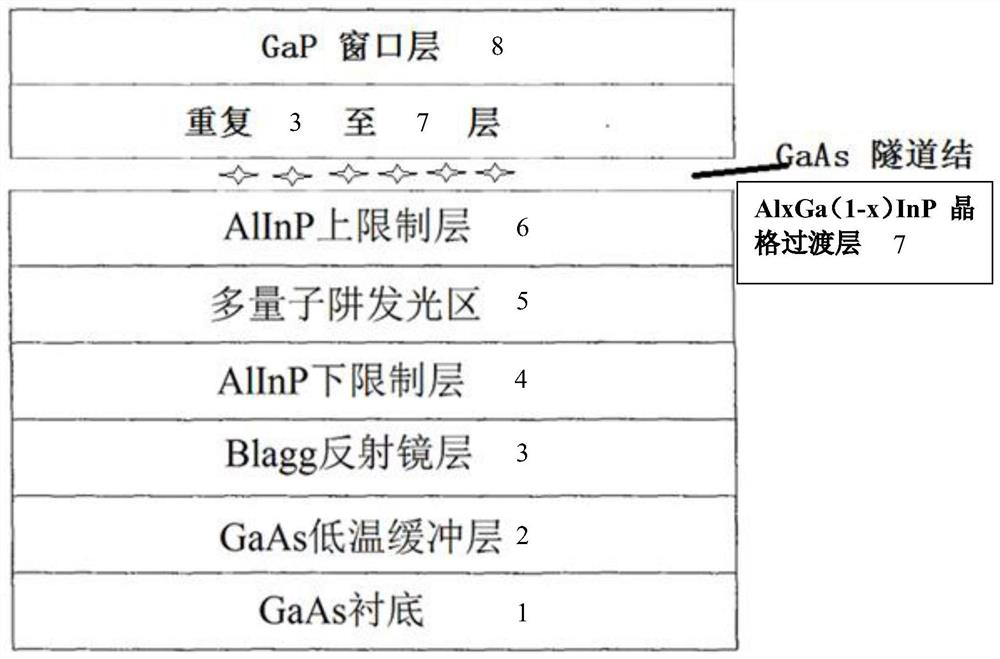GaAs-based multi-junction yellow-green light LED and preparation method thereof
A yellow-green light, confinement layer technology, applied in the field of optoelectronics, can solve the problems of lattice defects, low production yield, and poor epitaxial deposition efficiency at the edge of the carrier disc.
- Summary
- Abstract
- Description
- Claims
- Application Information
AI Technical Summary
Problems solved by technology
Method used
Image
Examples
Embodiment 1
[0056] A GaAs-based multi-junction yellow-green LED, such as figure 1 As shown, from bottom to top, it includes GaAs substrate 1, GaAs low-temperature buffer layer 2, Blagg mirror layer 3, AlInP lower confinement layer 4, multiple quantum well light-emitting region 5, AlInP upper confinement layer 6, AlxGa(1-x)InP The lattice transition layer 7 and the tunnel junction of GaAs material, the Blagg reflector layer 3 to the AlxGa(1-x)InP lattice transition layer 7 are grown repeatedly, and finally the GaP window layer 8 is grown.
Embodiment 2
[0058] A GaAs-based multi-junction yellow-green LED, the structure of which is shown in Example 1, the difference is that the tunnel junction of the GaAs material is formed by a GaAs-doped P-type layer, a GaAs intrinsic layer and a GaAs-doped N-type layer.
Embodiment 3
[0060] A method for preparing a GaAs-based multi-junction yellow-green LED, comprising the steps of:
[0061] 1) GaAs substrate 1 is placed in the MOCVD equipment growth chamber, H 2 The environment is heated to 750±20°C and baked for 40 minutes, and the AsH 3 , remove water and oxygen on the surface of the GaAs substrate 1 to complete the surface heat treatment, and prepare for step 2);
[0062] 2) Slowly lower the temperature to 700±20°C, the cooling time is 80 seconds, and feed TMGa and AsH 3 , growing a GaAs low-temperature buffer layer 2 with a thickness of 0.5um on the GaAs substrate;
[0063] 3) Keep the temperature at 700±20°C, and continue to feed TMGa, TMAl and AsH 3 , growing a Bragg reflector layer 3 on the GaAs low-temperature buffer layer 2 grown in step 2), where the Bragg reflector layer 3 is AlGaAs;
[0064] 4) The temperature is lowered to 650±20°C, and an n-type AlInP lower confinement layer 4 is grown on the Bragg mirror layer 3 grown in step 3);
[00...
PUM
| Property | Measurement | Unit |
|---|---|---|
| Thickness | aaaaa | aaaaa |
| Thickness | aaaaa | aaaaa |
Abstract
Description
Claims
Application Information
 Login to View More
Login to View More - R&D Engineer
- R&D Manager
- IP Professional
- Industry Leading Data Capabilities
- Powerful AI technology
- Patent DNA Extraction
Browse by: Latest US Patents, China's latest patents, Technical Efficacy Thesaurus, Application Domain, Technology Topic, Popular Technical Reports.
© 2024 PatSnap. All rights reserved.Legal|Privacy policy|Modern Slavery Act Transparency Statement|Sitemap|About US| Contact US: help@patsnap.com








